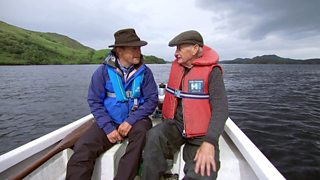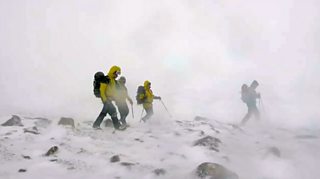Why you should take the Loch Ness Monster more seriously
22 May 2019
Westeros isn’t the only place to harbour a large-scale, long-necked mythical creature capable of capturing the imagination of millions.
Scotland’s own monster, ‘Nessie’, has been keeping us guessing far longer than Drogon the dragon from Game of Thrones.
Our obsession with the Loch Ness Monster shows no signs of dwindling
So just how has this formidable creature, first reported in 1933, maintained her iconic status?
Should we be shunning the ‘influencers’ and instead taking inspiration from a powerful female icon who maintains her mystique?
Here are eight reasons we should take this maiden of the Loch more seriously.
Nessie: a great Scottish legend

-
Photo from
Pop culture loves her

Nessie has inspired countless films, TV shows and comedy sketches — not least of which is this sequence from Scotland Unsolved, a new comedy series featuring two detectives investigating real-life mysteries.
Known from the hit mockumentary Scot Squad, DCs Squire and McGill – played by Julie Wilson Nimmo and Louise McCarthy – certainly aren’t the only ones to find inspiration in the waters of Loch Ness.
Doctor Who, The Simpsons and South Park have all incorporated Nessie into their storylines.
Nicole Sturgeon believes

During an interview with ITV’s Good Morning Britain, Scotland’s First Minister Nicola Sturgeon said, with a smile, that she believes in the Loch Ness Monster.
During 2014’s Scottish independence referendum, a wooden sculpture of Nessie – a landmark on a roundabout in Inverness – had a sign placed on it that read ‘Yessie’.
Harry Potter & Game of Thrones have gotten us all fired up

With the huge success of fantasy titles in recent times such as Harry Potter and Game of Thrones, is it any wonder we’ve developed a renewed interest in the existence of our own mythical creatures?
Stories about dragons have always taken their inspiration from real-world animals. explores whether evolution could feasibly give rise to dragons.
Nessie might be bigger (online) than Donald Trump

In July 2018, Farming Today sent reporter Jackie O’Brien to investigate whether Nessie’s appeal is on the wane.
She reported a claim by Gary Campbell, Keeper of the Register of Sightings at Loch Ness, that there are more mentions of Nessie on the internet each month than Donald Trump.
She has kin! A lesser-known cousin called Morag

Nessie isn’t the only loch monster spotted in Scotland, according to this man who spoke to Paul Murton, presenter of Grand Tours of Scotland’s Lochs, in 2017.
Morag also pronounced ‘Voorag’ is the monster of Loch Morar.
As well as this witness, there are reported sightings dating back to 1887. 16 of these involved multiple witnesses.
She may be immortal

According to the Official Loch Ness Monster Sightings Register, which is now 20 years old, there are about ten Nessie sightings a year. The latest occurred in April 2019 and was captured on film.
From ‘v-shaped wakes’ to ‘large double humped objects’, people from all walks of life – and from all over the world – report sightings to the official database.
There have been unsettling accounts of a strange, dinosaur-shaped creature who lives in the Loch from as far back as the sixth century, which would make Nessie 1500 years old.
She is a protected species (of sorts)

Established 20 years ago, there exists a code of practice in the event that Nessie is ever found.
Scottish Natural Heritage (SNH), a Scottish government-funded body, created the code in 2001 when Nessie-hunting was at its peak.
It stipulates that a DNA sample should be taken from any new creature, and then it should be released back into the loch.
Perhaps the most famous Nessie photograph, taken in 1934.
She’s worth millions to Scotland’s economy

Despite some theories that Nessie is a tourist conspiracy, Scotland’s national tourist board doesn’t shy away when it comes to the debate on her existence.
From :-
“Nessie does really exist, and there are over 1,000 eye witness accounts and lots of unexplained evidence, leaving scientists baffled.”
Photograph by Jeff Zycinski.
-
![]()
Scotland Unsolved on ����ý iPlayer
New comedy from the makers of Scot Squad, featuring two detectives investigating real-life mysteries.
- Also on ����ý iPlayer: Scot Squad
Latest features from ����ý Scotland
-
![]()
'Wild swimming helps me process the grief of losing my son'
The benefits of cold water therapy.
-
![]()
Winter adventures are appealing, but an expert advises caution
Trips in winter require particular knowledge and skills.
-
![]()
The rescuers: Why volunteers risk their lives in mountain emergencies
Landward meets members of the Cairngorm Mountain Rescue Team.
-
![]()
‘Look for the light’ – practical tips to help you through another winter with SAD
Useful advice and tips to combat low moods at this time of year.
-
![]()
How you could be a binge drinker without even knowing
Binge drinking is classed as fewer units than many people may realise.
-
![]()
How chocolate biscuits and drama classes helped one man leave prison behind
The healing power of creativity.
-
![]()
'When people believe in you, it’s life-changing'
Author Graeme Armstrong revisits the man who helped turn his life around.
-
![]()
The 'breath-taking' display of US birds swept on to British soil
Recent storms have brought rare birds to our shores.
-
![]()
Six things we learned about Alan Cumming on Take the Floor (Spoiler: includes accordions)
The actor spoke to Take the Floor's Gary Innes.
-
![]()
How street gangs trap young men in a dangerous cycle of violence
The almost inescapable pull of life in a gang.
-
![]()
Why stylist Gok Wan believes there's no such thing as bad fashion
The fashion expert says we should stop following rules and do what feels right.
-
![]()
Is sending a CV still the right way to apply for a job?
They've been central to job applications for years, but are they worth it?


















